
Amazon SEO Keywords are the phrases shoppers use to search for products on Amazon. And when you know the best keywords for your product, you can make sure your listing shows up in the right Amazon searches. This guide will show you how to find the most powerful Amazon keywords to optimize your product listings.
Amazon Keywords vs Google Keywords
Amazon keywords are very different to Google keywords. Why? Because Amazon and Google are two different search engines, serving different needs.
Just like keywords you’d use for Google, Amazon keywords are what shoppers type in Amazon's search bar to find products. But unlike Google where people search for information, on Amazon people search to shop.
So the keywords on Amazon are very different to Google. Amazon search terms are one of the most critical factors on which listings shoppers see and ultimately buy.
Improve Your Product Ranking on Amazon
To rank higher on Amazon, first you need to find the strongest keywords for your product. Amazon is a vast marketplace with thousands of sellers. To make your products stand out, you must capitalize on specific keywords relevant to your product niche and the shopper's intent. SEO optimization makes your listing more visible, leading to better ranking in the Amazon search results, more clicks and higher sales.
In the sections below, we’ll explain the main concepts of Amazon SEO and show you the steps, tools, and strategies to find the keywords you need to rank high on the world's biggest e-commerce platform. Let’s go!
Perci: AI Amazon Keyword Generator Tool
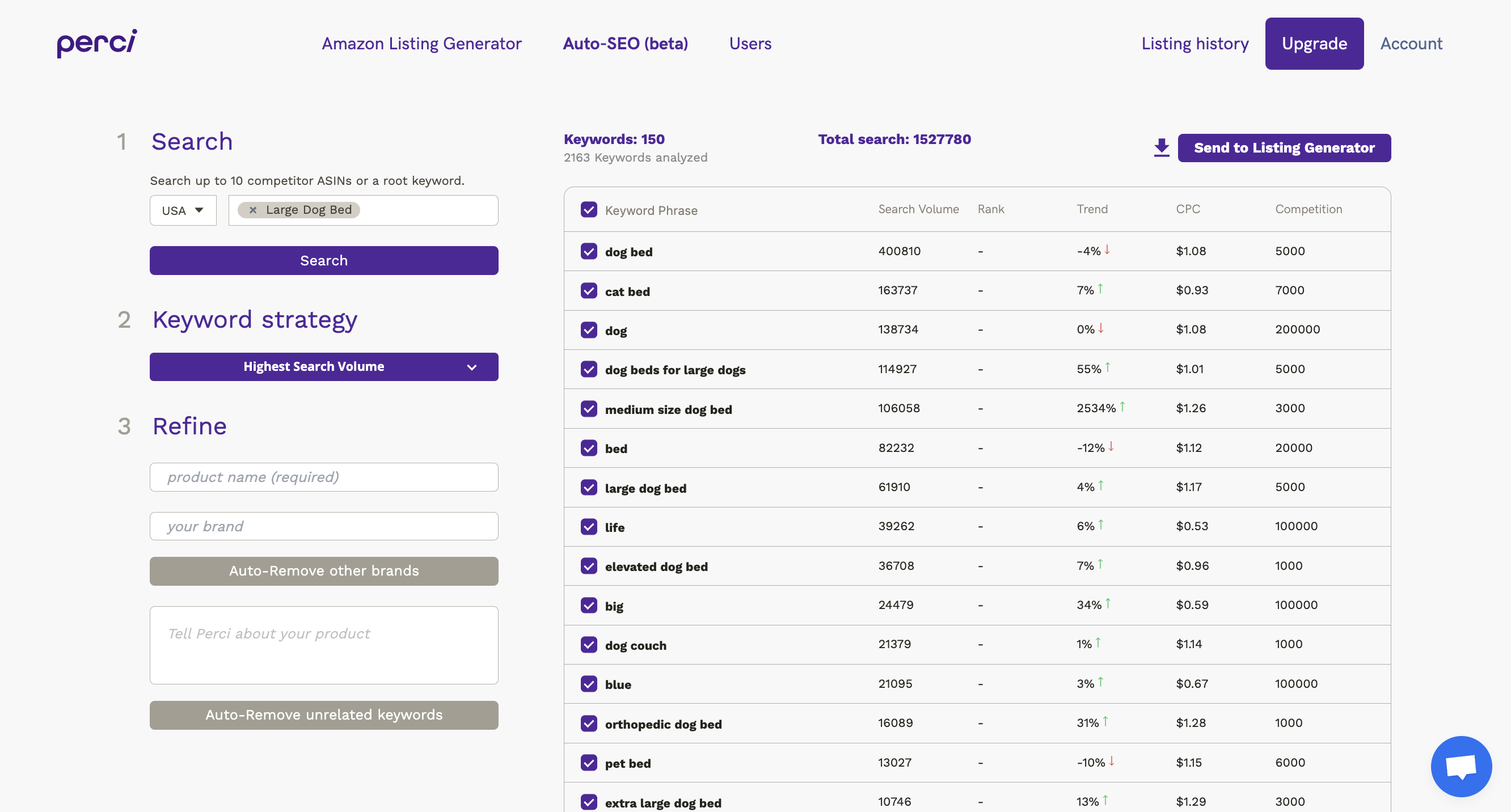
Want to skip all the work and find your most powerful Amazon keywords in a few minutes?
Perci uses AI to automatically find the best Amazon keywords for your product. It walks you through keyword research step-by-step, with complete control.
Try Perci free now: https://perci.ai
Okay—let's dive into how to find your keywords.
Free But Limited: Amazon Search Bar Autocomplete
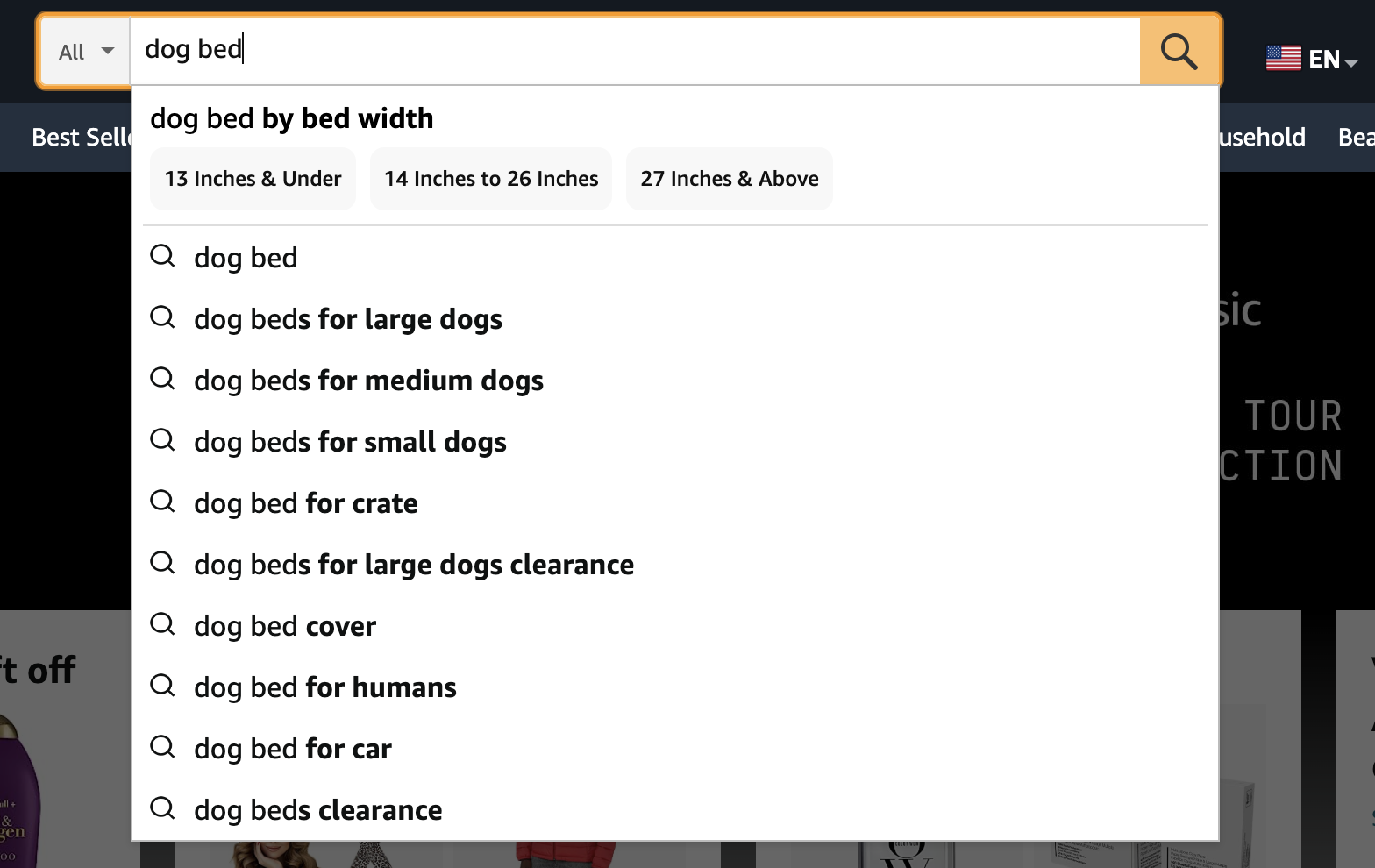
Unlike Google, Amazon doesn’t release keyword data. Some people suggest using Amazon’s search bar suggestions as a way to find Amazon keywords.
This can be a good way to find a few keywords, but if you’re serious about selling you won’t get very far with this method. You’re competing with sellers using professional tools that have keyword analytics, trends, sales data and more. This method is better than nothing, but only if you have no other option.
Amazon Keywords Tools
Sellers generally use specialised Amazon keywords tools to find the best keywords for their products.
Because Amazon doesn’t release keywords info, there are lots of Amazon seller tools that scrape Amazon data. With these tools it’s easy to search for keywords and get reliable data about search popularity, competition, sales data and more.
There are plenty of Amazon tools: Perci, JungleScout, Helium10 and Viral Launch to name a few. Using an Amazon-specific tool is crucial if you want to rank. Whichever one you use, the process will be the same—unless you’re using Perci, which will do it all automatically for you with AI.
Amazon SEO Research Overview
Whatever tools you use to do your SEO research, you should follow these three steps:
1. Gather:Find as many keywords as you can that apply to your product or market
2. Strategy: Decide what kind of keyword strategy you want to use to compete
3. Refine: Remove problem keywords and prioritise your remaining keywords by your strategy goals
We’ll dive into each of these steps in detail.
STEP 1: Gather Amazon SEO Keywords
The first step to finding the best Amazon keywords is looking far and wide to find as many as you can. Gathering keywords is the thorough and strategic process of discovering relevant and popular search terms that potential buyers are likely to use when searching for your product or something similar on Amazon.
There are two main methods commonly used for this: 'Root keyword’ searches and 'Reverse ASIN’ searching. Both methods have pros and cons, and all good Amazon tools will have both methods available.
Root keyword Search
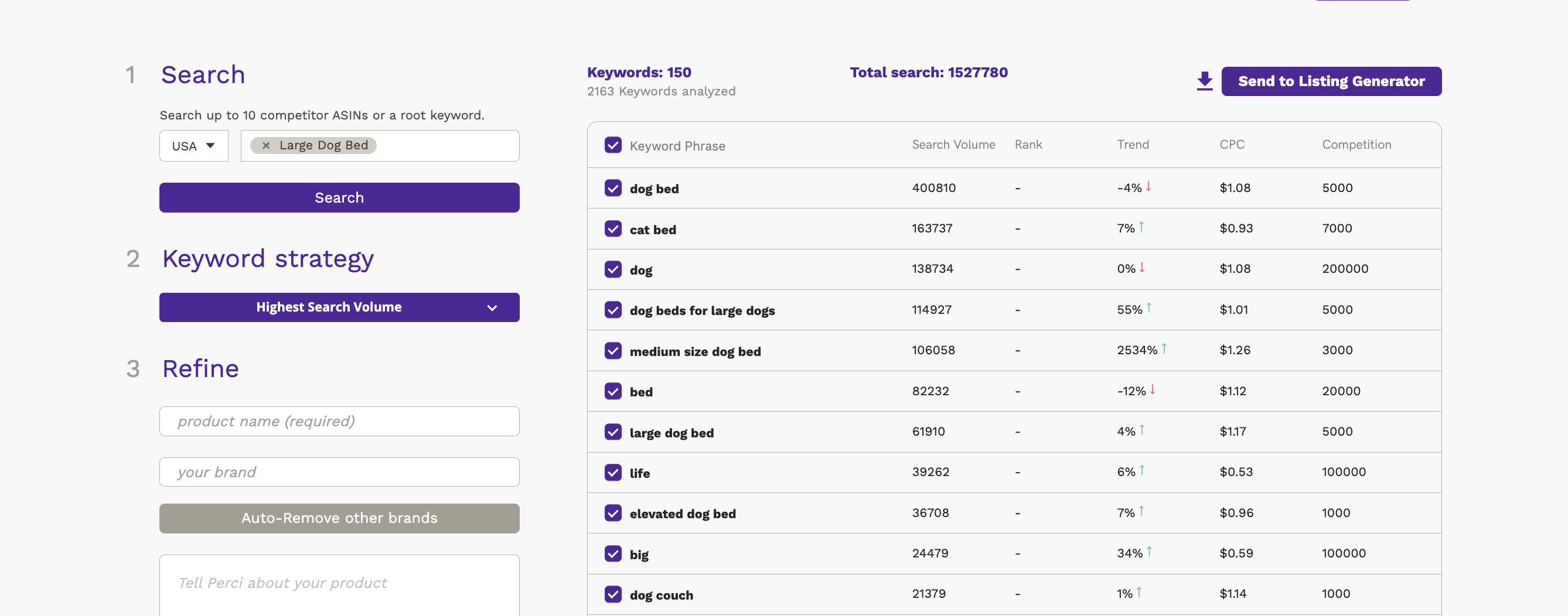
Root keyword searching starts with the most basic and general keyword relevant to your product—also known as the 'root' or 'seed' keyword. This root keyword can then be entered into an Amazon keyword tool to generate a long list of related keywords. For example, if you are selling running shoes, your root keyword might be “running shoes”.
The advantage of root keyword searching is its broadness. You can discover a wide array of keywords related to your product that you may not have thought of. On the flip side, this broadness can also be a disadvantage as it may lead to generic and highly competitive keywords.
Root keyword searching is also quick—you can get thousands of good search terms to work with in seconds.
Reverse ASIN Search
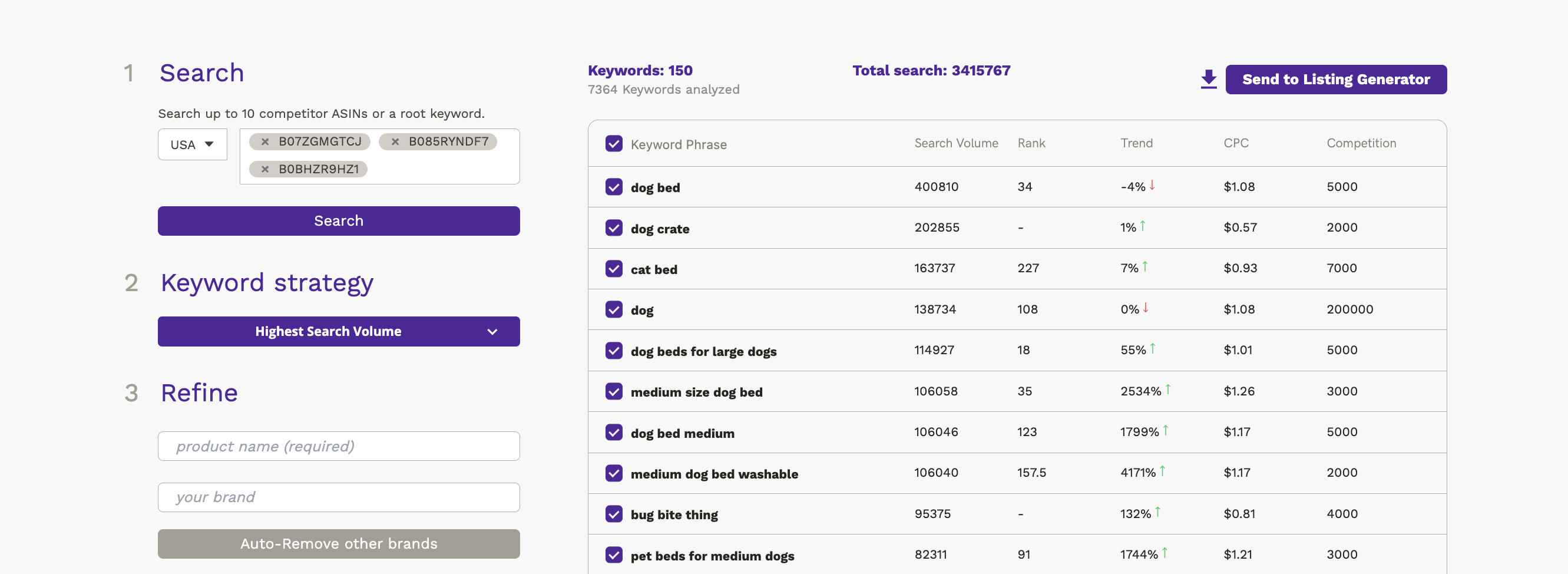
Reverse ASIN searching, on the other hand, involves analyzing your competitor’s amazon listings to find their most successful keywords.
By entering the Amazon Standard Identification Number (ASIN) of a competitor's product into an ASIN Lookup Tool, you can get a list of keywords they are ranking for. This method provides more specific, potentially more successful keywords that are relevant to your product niche.
This involves a bit more legwork, because you need to find the specific listings that you want to analyse. But typically you can just search for your product on Amazon and use the top 5-10 organic listings. After all, they’re ranking at the top for a reason, right?
Which Method Is Better?
Some SEO experts use a combination of root keyword and reverse ASIN searching. This way, you can benefit from the broadness of the root keyword method while also gaining specific insights from your competitors with the reverse ASIN search.
In practice, most sellers use root keywords if they’re in a hurry, or if they can’t find many listings that compare to their product. Otherwise, Reverse ASIN is typically a better bet because it’s based on already-successful listings.
STEP 2: Pick Your Keyword Strategy
Now that you’ve gathered all the relevant keywords for your product, you can decide which SEO strategy is best for your listing.
SEO strategy is all about which type of keywords you want to target. This is a critical step to a high-ranking listing on Amazon. There is no one-size-fits-all strategy, and it depends on how big a seller you already are, the market you’re targeting and the keyword data you discover.
Without a strategy, you might find yourself using keywords that don't match buyer preferences or are overly competitive, leading to lower visibility and sales.
Here are all the top Amazon keyword strategies, and why and when you might want to use them.
Highest Search Volume
This one is simple: go for the most popular search terms. It’s one of the most common approaches to Amazon SEO.
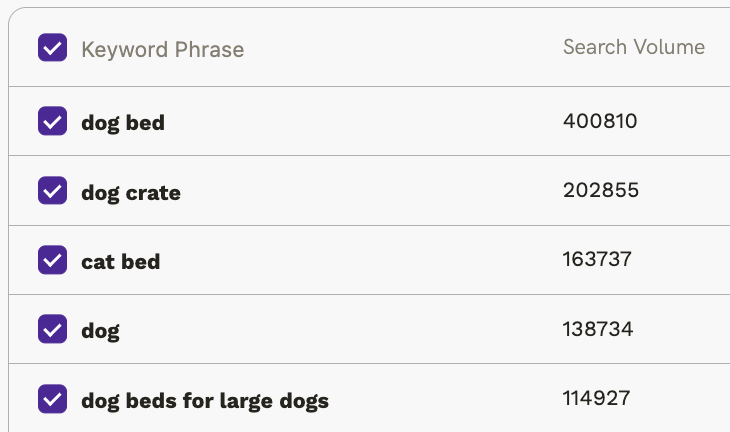
Prioritizing high monthly searches often means more eyes on your product. But remember, high-volume keywords are usually very competitive, and ranking for them as a new or smaller seller can be challenging. If you don’t want to get too into the details, this is a simple strategy that typically does well.
Long-Tail Keywords
Long-Tail Keywords are less popular, but much more specific search phrases. They are typically phrases with three or more words that speak directly to a user's search intent.
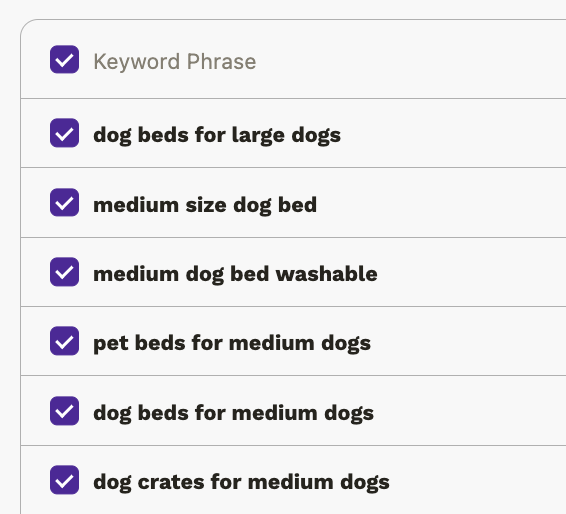
Long-tail keywords have lower search volumes, but lower competition and higher conversion rates because of they are very specific. For instance, a customer searching for "men's waterproof trail running shoes size 11" is closer to making a purchase than someone searching for "sports shoes.”
This is a great strategy if you’re a small or beginning seller, as you can compete for a smaller, less competitive audience using extremely relevant keywords to your product.
If you’re using most Amazon tools, you’ll need to find Long-tail keywords manually. But Perci uses AI to find these automatically.
Trending Keywords
The trending keyword strategy is all about capitalizing on recent or seasonal trends to boost visibility and sales. For example, during the holiday season, incorporating keywords related to gifts can help improve your product’s discoverability.
Amazon SEO is always changing—some keywords explode in popularity and others suddenly disappear. Trending keywords is another way for small sellers to find a competitive edge against larger competitors who may not be as quick to react to SEO changes.
But beware: if you use trends to choose keywords, you’ll need to check your keywords very often to make sure the trends don’t start heading the other direction.
Competitor Rank

The competitor rank strategy is all about using the keywords your biggest competitors are ranking for, to ride on their success. It’s a very popular strategy with all sellers, especially in markets where competition is fierce. Look at the keywords your high-ranking competitors are using. If they're finding success with particular keywords, it may be worth incorporating these into your own SEO strategy.
Of course, this strategy only works if you’ve done a reverse ASIN search. And the key to this strategy is picking the right competitors to analyze.
Complex SEO Strategies
Lastly, there are more complex strategies that try to find keywords the rest of the market has missed.
One example is called ‘opportunity’, or ‘outlier’ keywords. These are keywords with low competition but good search volume potential. They provide an opportunity for smaller or newer sellers to rank on promising keywords that the broader market hasn’t discovered yet.
These complex strategies can sometimes yield great keywords, but they require more legwork to dig up—which, if you’re willing to do the work, can give you an edge.
Every Amazon seller and product is unique—your ideal strategy depends on your specific goals, customer base, product niche, and level of competition. Trial and error, and persistently monitoring keyword performance, will eventually lead you to the strategy that works best for your Amazon product listing.
STEP 3: Refine Your Keywords List
You’ve gathered all the possible keywords and chosen your SEO strategy—now it’s time to cull your final keyword list. You’ll have thousands of possible keywords, and we want to find the top 25 or 30 to use in your listing. You don’t need to refine your entire keyword list—you only need to refine until you have enough keywords, and you can leave the rest alone.
Keywords Analysis Tool
Along with the keywords, your Amazon tool will show you data about each keyword. This is how you'll map your Keywords strategy onto your keywords: simply sort by the criteria you want, whether it’s search volume, trends, rank or something else.
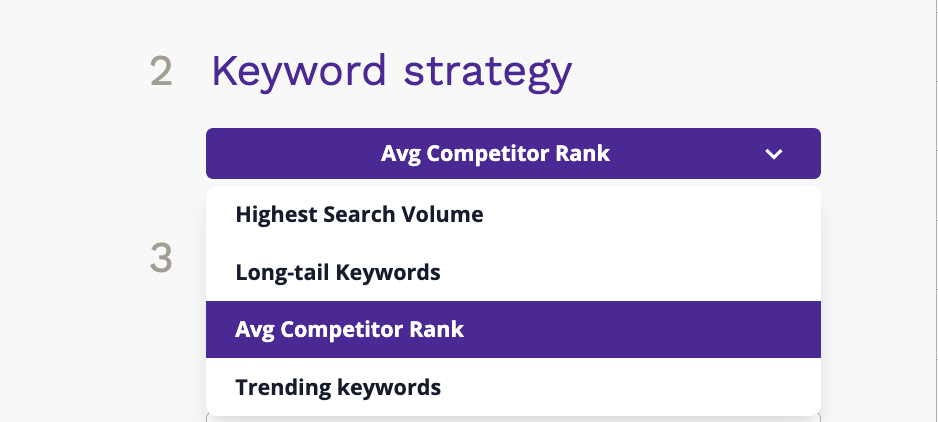
This strategy sorting is just the start. Not every term will be applicable, beneficial, or even compliant with Amazon's rules. So you need to check each phrase closely. Here are the types of phrases you want to remove, and why it’s important to remove them:
Branded terms
These are terms with established brands in them, like ‘Apple watch’ or ‘Unilever daily moisturizer’. Although these terms might have high search volume, Amazon strictly prohibits other brands' names in your listing unless you're selling that particular brand.
For example, if you're selling generic running shoes, you can’t use terms like 'Nike' or 'Adidas' in your keywords. That will get you into all kind of trouble with Amazon investigators. Remove these.
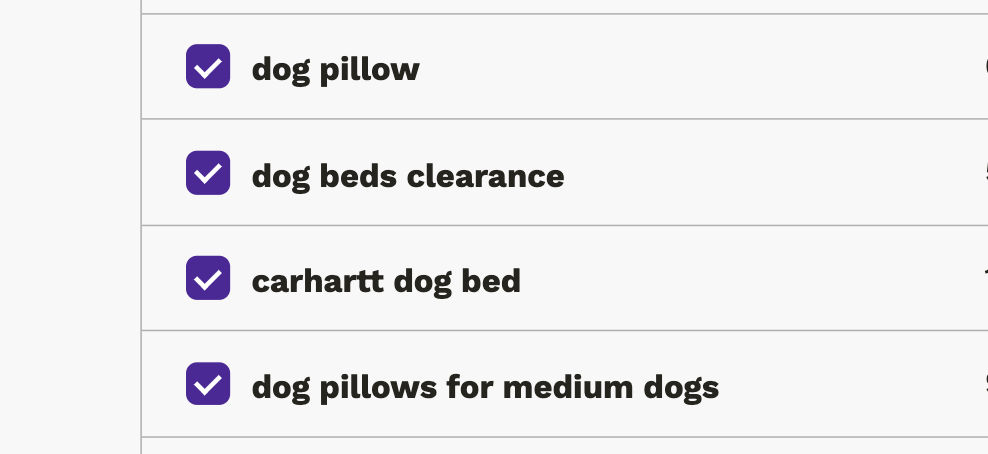
Pro tip: it’s a grey area, but many sellers take branded terms and use them in their listing’s backend keywords, which aren’t visible on the listing. Something to consider.
Irrelevant keywords
Amazon keyword searches typically contain a lot of irrelevant keywords and phrases that don’t make sense for your product. Things like ‘Sunday deals’, or ‘TikTok products’.
Likewise, you’ll often have keywords that are in the ballpark but have wrong details: if you’re selling a large dog bed, you don’t want the keyword ‘small dog bed’. Someone who searches that won’t want your product.
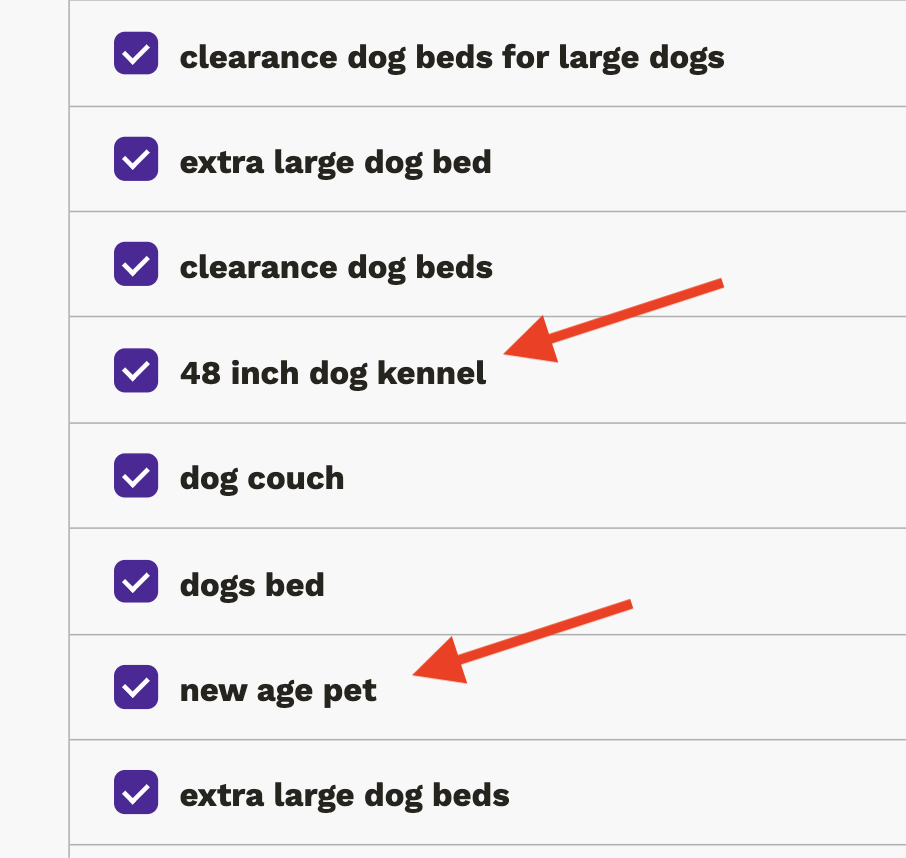
The keywords you use should align exactly with what you're selling. Even if a keyword has a high search volume, if it's not 100% related to your product, using it might attract the wrong audience and lead to low conversion rates, which can negatively impact your product ranking on Amazon.
Foreign Language Keywords
This is up for debate, but most sellers will remove foreign language keywords from their main listing. Often if you’re in the USA you will see Spanish keywords which would look out of place in your listing. Save the foreign languages for your backend.
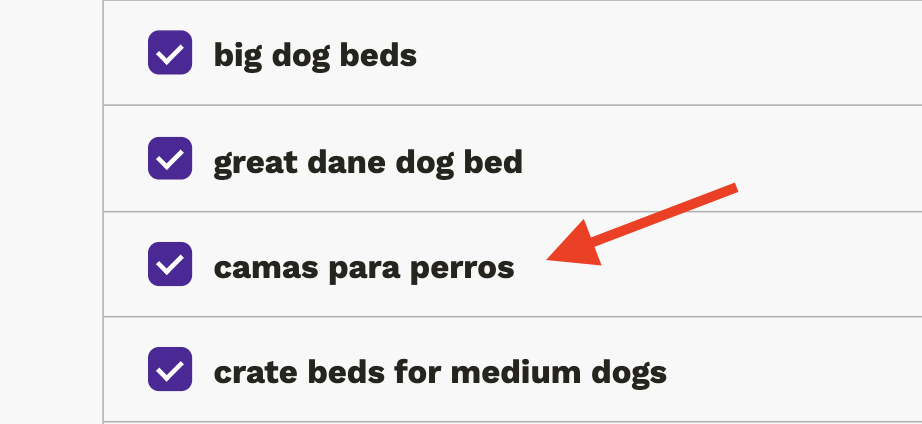
Refining is about quality, not quantity. Instead of focusing on how many keywords you have, direct your attention towards the relevance and effectiveness of each keyword. Removing irrelevant or ineffective terms in your keyword list increases your chances of reaching the right audience and gaining more sales.
Perci Amazon Keywords Tool
Now that you see the process of finding Amazon keywords, you understand the work involved. Amazon is competitive—the deeper you dig for the best keywords, the better advantage you have over other sellers.
But you don’t need to do all the work yourself. Perci’s Auto-SEO tool is the first AI-powered Amazon Keywords Generator that allows you to gather, sort and refine your keywords automatically in a few minutes.
It uses powerful custom AI to spot branded keywords and irrelevant keywords, so you know that your listing SEO is targeted and effective.
Next: Optimize Your Amazon Listing
Now that you have your keyword list, it’s time to optimize them into your title, bullets, description and backend.
That’s a huge topic on its own, and there are a lot of resources out there about optimising your keywords like Amazon’s own guide, this rundown of tips or our own pro copywriting secrets.
Or if you’re using Perci, all your keywords will optimize automatically thanks to AI.
Remember: the Amazon marketplace is dynamic, with customer trends, marketing strategies and preferences constantly changing over time. So your keywords should never be static or set in stone.
It takes effort, but the results are worth it. From higher product rankings, improved visibility to increased sales, the potential benefits are immense.
Happy selling!